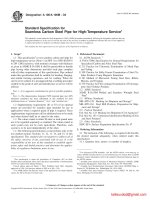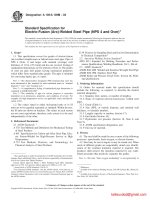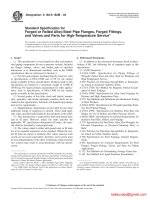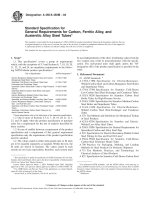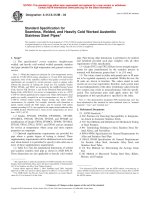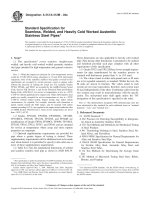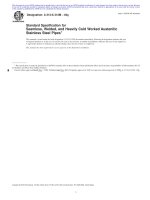Astm astm f 1066 04 (2014)e1
Bạn đang xem bản rút gọn của tài liệu. Xem và tải ngay bản đầy đủ của tài liệu tại đây (100.4 KB, 5 trang )
Designation: F1066 − 04 (Reapproved 2014)´1
Standard Specification for
Vinyl Composition Floor Tile1
This standard is issued under the fixed designation F1066; the number immediately following the designation indicates the year of
original adoption or, in the case of revision, the year of last revision. A number in parentheses indicates the year of last reapproval. A
superscript epsilon (´) indicates an editorial change since the last revision or reapproval.
This standard has been approved for use by agencies of the U.S. Department of Defense.
ε1 NOTE—The keyword VCT was added to Section 17 in December 2014.
1. Scope
F2055 Test Method for Size and Squareness of Resilient
Floor Tile by Dial Gage Method
F2199 Test Method for Determining Dimensional Stability
of Resilient Floor Tile after Exposure to Heat
2.3 Other Standards:
ANSI/ASQC Z1.4 Sampling Procedures and Tables for Inspection by Attributes3
1.1 This specification covers vinyl composition tile (VCT)
with either smooth or embossed surfaces for flooring application.
1.2 The values stated in inch-pound units are to be regarded
as standard. The values given in parentheses are mathematical
conversions to SI units that are provided for information only
and are not considered standard.
1.3 This standard does not purport to address all of the
safety concerns, if any, associated with its use. It is the
responsibility of the user of this standard to establish appropriate safety and health practices and determine the applicability of regulatory limitations prior to use.
3. Classification
3.1 The vinyl composition floor tile covered by this specification shall be non-asbestos formulated and classified as
follows: Class 1 for solid tile, Class 2 for through pattern tile,
and Class 3 for surface pattern tile. These may have either
smooth or embossed wearing surfaces.
2. Referenced Documents
4. Ordering Information
2.1 The following documents of the issue in effect on the
date of material purchase form a part of this specification to the
extent referenced herein:
4.1 The purchaser shall state whether this specification is to
be used, select the preferred options permitted herein, and
include the following information in the invitation to bid and
purchase order:
4.1.1 Title, number, and date of this specification,
4.1.2 Class, color, pattern, and wearing surface, (see Section
3),
4.1.3 Quantity in square feet or cartons,
4.1.4 Size required, (see 6.1),
4.1.5 Thickness required (see 6.2),
4.1.6 Lot formation if other than as specified in ANSI/
ASQC Z1.4 (see Sections 11 and 13),
4.1.7 Sampling, if other than as specified in ANSI/ASQC
Z1.4 (see Sections 11 and 13),
4.1.8 Packing requirements if other than as specified (see
15.1),
4.1.9 Depth of depressed areas, if required,
4.1.10 Palletization, if required (agreed upon between the
manufacturer and the purchaser),
4.1.11 Marking, if other than specified (agreed upon between the manufacturer and the purchaser), (see 14.1), and
2.2 ASTM Standards:2
F386 Test Method for Thickness of Resilient Flooring Materials Having Flat Surfaces
F925 Test Method for Resistance to Chemicals of Resilient
Flooring
F1265 Test Method for Resistance to Impact for Resilient
Floor Tile
F1304 Test Method for Deflection of Resilient Floor Tile
F1514 Test Method for Measuring Heat Stability of Resilient
Flooring by Color Change
F1914 Test Methods for Short-Term Indentation and Residual Indentation of Resilient Floor Covering
1
This specification is under the jurisdiction of ASTM Committee F06 on
Resilient Floor Coverings and is the direct responsibility of Subcommittee F06.80
on Specifications.
Current edition approved Nov. 1, 2014. Published December 2014. Originally
approved in 1987. Last previous edition approved in 2014 as F1066 – 04(2014)ε1.
DOI: 10.1520/F1066-04R14E01.
2
For referenced ASTM standards, visit the ASTM website, www.astm.org, or
contact ASTM Customer Service at For Annual Book of ASTM
Standards volume information, refer to the standard’s Document Summary page on
the ASTM website.
3
Available from American National Standards Institute, 11 West 42nd St., New
York, NY 10036.
Copyright © ASTM International, 100 Barr Harbor Drive, PO Box C700, West Conshohocken, PA 19428-2959. United States
1
F1066 − 04 (2014)´1
with the requirements of Table 1, and shall correspond to the
indentation recorded at the end of 1 min.
7.1.3 When tested in accordance with Test Method F1914 at
a temperature of 115°F (46.1°C), the indentation shall be less
than 0.032 in. (0.813 mm) at the end of 30 s.
7.1.4 Embossed Tile—When the requirement for flat surface
as set forth in Test Method F1914 cannot be met, the test shall
be made by the manufacturer on unembossed stock and the
manufacturer shall supply a certificate of compliance.
4.1.12 Other requirements (agreed upon between the manufacturer and the purchaser).
5. Materials and Manufacture
5.1 Materials—The tile shall be composed of binder, fillers,
and pigments. The binder shall consist of one or more resins of
poly(vinyl chloride) or vinyl chloride copolymers, or both,
compounded with suitable plasticizers and stabilizers. Other
suitable polymeric resins may be incorporated as a part of the
binder.
7.2 Impact—When the tile is tested in accordance with Test
Method F1265, the tile shall not break or crack beyond the
prescribed circle of zinc oxide paste.
7.2.1 For 1⁄8-in. (3.175-mm) tile the weight shall be dropped
from a height of 20 in. (508 mm). For tile gage less than 1⁄8-in.
(3.175-mm), the weight shall be dropped from a height of 10
in. (254 mm). Test all products with a 0.143-lb (0.065-kg)
weight dropped 4 times.
7.2.2 When testing embossed tile, inscribe a 3 6 1⁄8-in.
(76.2 6 3.175-mm) diameter circle centrally on the back of
each specimen with a felt pen, pencil, or other suitable marker.
Do not use the zinc oxide paste specified in Test Method
F1265. Cracks should not go beyond the 3 6 1⁄8-in. (76.2 6
3.175-mm) diameter circle. The test shall be run on the
specimen with the wearing surface up.
5.2 Color, Pattern, and Wearing Surface—The color,
pattern, and wearing surface, as applicable shall be as specified
in the contract or order (see 4.1).
NOTE 1—The colors and patterns that are available are indicated in
individual manufacturer’s current catalogs. As manufactured, colors vary
somewhat in hue and shade.
5.3 Solid Color Tile—Solid color tile shall be uniform
throughout.
5.4 Through Pattern Tile—In through pattern tile, either the
pattern and colors on the surface of the tile extend entirely
through the thickness of the tile without significant change, or
the colors appearing on the surface shall extend throughout the
entire thickness of the tile, although the appearance of the
pattern created by these colors will change throughout the
thickness.
8. Performance Requirements
8.1 Deflection—The tile, when tested in accordance with
Test Method F1304, shall deflect not less than 1.0 in. (25.4
mm) both across and with the grain, without breaking.
5.5 Surface Pattern Tile—The pattern of this tile need not
extend through the entire thickness of the tile.
5.5.1 The appearance of the tile, when the wearing layer is
removed to a depth of 0.010 in. (0.254 mm), shall compare
favorably for decoration with the tile’s original appearance.
The removal of the wearing layer may be accomplished by any
suitable method.
8.2 Dimensional Stability—When tested in accordance with
Test Method F2199, the linear dimensions shall not change
more than 0.024 in. (0.610 mm) per linear foot.
8.3 Resistance to Chemicals:
8.3.1 The chemical resistance of the tile shall be determined
in accordance with Test Method F925. Vinyl composition floor
tile shall have no more than a slight change in surface dulling,
surface attack, or staining when exposed to the following
chemicals:
8.3.1.1 White vinegar (5 % acetic acid),
8.3.1.2 Rubbing alcohol (70 % isopropyl alcohol),
8.3.1.3 White mineral oil (medicinal grade),
8.3.1.4 Sodium hydroxide solution (5 % NaOH),
8.3.1.5 Household ammonia solution (5 % NH4OH),
8.3.1.6 Household bleach (5.25 % NaOCl),
8.3.1.7 Olive oil (light),
8.3.1.8 Kerozene (K1),
8.3.1.9 Unleaded gasoline (regular grade), and
8.3.1.10 Phenol (5 % active phenol).
6. Physical Properties
6.1 Size—Unless otherwise specified (see 4.1.4), the tile
shall be 12 by 12 in. (305 by 305 mm). A tolerance of 60.016
in. (0.406 mm) per linear ft (305 mm) shall be permitted when
measured in accordance with Test Method F2055. Certain
specialty items are available in other sizes.
6.2 Thickness—Unless otherwise specified (see 4.1.5), the
tile shall be furnished in 1⁄16 –in. (1.588-mm), 3⁄32-in. (2.381mm), and 1⁄8-in. (3.175-mm) thickness. A tolerance of 60.005
in. (0.127 mm) shall be permitted when measured in accordance with Test Method F386.
6.3 Squareness—When tested in accordance with Test
Method F2055, the out-of-squareness of the tile shall not
exceed 0.010 in. (0.254 mm).
TABLE 1 Ten Minute Indentation
7. Mechanical Properties
7.1 Indentation:
7.1.1 When the tile is tested in accordance with Test Method
F1914 at a temperature of 77°F (25°C), the indentation at the
end of 1 min shall be not less than 0.006 in. (0.152 mm), and
not more than 0.015 in. (0.381 mm).
7.1.2 When tested in accordance with Test Method F1914
the indentation at the end of 10 min shall be in conformance
1 min
in.
0.006
0.007
0.008
0.009
0.010
2
After
10 min, max
After
10 min, max
1 min
mm
in.
mm
in.
mm
in.
mm
0.152
0.178
0.203
0.229
0.254
0.0100
0.0112
0.0124
0.0137
0.0149
0.254
0.284
0.315
0.348
0.378
0.011
0.012
0.013
0.014
0.015
0.279
0.305
0.330
0.356
0.381
0.0162
0.0174
0.0186
0.0197
0.0209
0.411
0.442
0.472
0.500
0.531
F1066 − 04 (2014)´1
NOTE 2—The basic chemicals are representative of those likely to be
found in residential, commercial, and institutional use. Many proprietary
compounds contain one or more of these basic chemicals. Should the
flooring for an unusual application need to be resistant to a specific
chemical, this additional requirement should become part of the procurement document.
I, and the acceptable quality level (AQL) shall be 6.5 defects
per hundred units as noted in Table II-A or as otherwise
specified in 12.2 herein. The lot size shall be expressed in units.
A unit represents a single, manufactured, inventoried, finished
tile.
8.4 Resistance to Heat—When tested in accordance with
Test Method F1514, the color change of the vinyl composition
floor tile shall have an average ∆E not greater than 8.0 after 7
days exposure to 158°F (70°C).
12.2 Inspection of the vinyl composition floor tile for
defects that would adversely affect performance shall be agreed
upon by the purchaser and the manufacturer as part of the
procurement document.
9. Workmanship, Finish, and Appearance
13. Certification
9.1 The floor tile furnished in accordance with this specification shall be an acceptable match to approved samples in
pattern, color, and surface appearance. The product shall be
free of defects that adversely affect performance or appearance.
Such defects include blemishes, spots, indentations, cracks,
blisters, and breaks in corners or edges.
13.1 When specified in the purchase order or contract, a
manufacturer’s certification and any other documents required
to substantiate certification shall be furnished to the purchaser
that the material was manufactured to meet this specification.
14. Product Marking
14.1 Unless otherwise specified in the purchase order or
contract, shipping containers shall be marked with the name of
the material as defined by the contract or order under which the
shipment is made, the size, thickness, the pattern number, the
quantity contained therein and the name of the manufacturer or
shall be as specified in 4.1.
10. Sampling
10.1 Sampling for testing physical properties, mechanical
properties, and performance requirements listed in Table A1.1
shall be done in accordance with the provisions set forth in
ANSI/ASQC Z1.4. The inspection level shall be special
inspection level S-1, as noted in Table I, and the acceptable
quality level (AQL) shall be 6.5 defects per hundred units as
noted in Table II-A or as otherwise specified in 10.2 herein. The
lot size shall be expressed in units. A unit represents a single,
manufactured, inventoried, finished tile.
14.2 When product sample sets, sample set cover cards,
marketing and technical literature reference this specification,
the complete products classification information relative to this
specification shall be included.
15. Packaging and Packing
10.2 Sampling for testing physical properties, mechanical
properties, and performance requirements listed in Table A1.1
shall be agreed upon by the purchaser and the manufacturer as
part of the procurement document.
15.1 The vinyl composition floor tile shall be packaged in
accordance with normal commercial practice and packed to
ensure acceptance by common carrier and to provide protection
against damage during normal shipping, handling, and storage
or shall be as specified in 4.1.8.
11. Conditioning
11.1 Conditioning in Air—Condition the specimens for
physical tests in air maintained at 73.4 6 3.6°F (23 6 2°C) and
50 6 5 % relative humidity for not less than 3 h before testing.
16. Special Government Requirements
16.1 The depressed areas of embossed tile shall involve no
more than one third of the original, flat tile surface area prior
to embossing as measured on a full tile. On embossed tile, there
shall be no depressed area into which a 5⁄8-in. (15.875-mm)
diameter circle can be placed, except that this shall not apply to
tile that have an overall embossed surface, such as brick, slate,
or other textures.
11.2 Conditioning in Water—Maintain the water temperature at 77 6 0.9°F (25 6 0.5°C) unless otherwise specified.
Immerse the specimen for not less than 15 min or more than 30
min before testing in either air or water.
12. Inspection
12.1 Inspection of the vinyl composition floor tile for
defects that would adversely affect performance shall be done
in accordance with the provisions set forth in ANSI/ASQC
Z1.4. The inspection level shall be level L-1, as noted in Table
17. Keywords
17.1 resilient flooring; tile; vinyl composition floor tile;
vinyl composition tile (VCT) ; VCT
3
F1066 − 04 (2014)´1
ANNEX
(Mandatory Information)
A1. CHARACTERISTICS AND TESTS
TABLE A1.1 Characteristics and Tests
Characteristic
Composition of wearing surface
Size, tolerance
Thickness
Resistance to heat
Indentation (flat surface)
77°F (25°C)—1 min
77°F (25°C)—10 min
115°F (46°C)—30 s
Indentation (embossed surface)
Impact
Deflection (MD and AMD)
Dimensional stability
Resistance to chemicals
Squareness
A
Requirement
Test Method
Reference
±0.016 in. (0.406 mm) per linear foot
±0.005 in. (0.127 mm), as specified
∆E not greater than 8.0
Certificate of Compliance
F2055
F386
F1514
5.1 – 5.5
6.1
6.2
8.4
F1914
F1914
F1914
A
F1914 or Certificate of Compliance
F1265
F1304
F2199
7.1.1
7.1.2
7.1.3
7.1.4
7.2
8.1
8.2
F925
8.3
F2055
6.3
0.006 to 0.015 in. (0.152 to 0.381 mm)
see Table 1
<0.032 in. (0.813 mm)
same as flat surface
No cracks beyond limit
1 in. (25.4 mm), min
0.024 in. (0.610 mm) per linear foot,
max
no more than a slight change in surface dulling, surface attack, or staining
0.010 in. (0.254 mm), max
Test Method F1914 cannot be used; the manufacturer will submit a certificate of compliance.
APPENDIX
(Nonmandatory Information)
X1. ADDITIONAL INFORMATION
X1.1 The following sources can be consulted for additional
information:
F1482 Guide to Wood Underlayment Products Available for
Use Under Resilient Flooring2
X1.1.1 ASTM Standards:
D3564 Practice for Application of Floor Polishes to Maintain Vinyl Asbestos Tile or Flooring2
F141 Terminology Relating to Resilient Floor Covering2
F373 Test Method for Embossed Depth of Resilient Floor
Coverings2
F510 Test Method for Resistance to Abrasion of Resilient
Floor Coverings Using an Abrader with a Grit Feed Method2
F511 Test Method for Quality of Cut (Joint Tightness) of
Resilient Floor Tile2
F710 Practice for Preparing Concrete Floors and Other
Monolithic Floors to Receive Resilient Flooring2
X1.1.2 Other Sources: Recommended Work Practices for
the Removal of Resilient Floor Coverings4
National Motor Freight Classification5
Uniform Freight Classification6
4
Available from Resilient Floor Covering Institute, 115 Broad Street, Suite 201,
LaGrange, GA 30240 (www.rfci.com).
5
Available from American Trucking Assoc., Inc., Tariff Order Section, 1616 P St.
N.W., Washington, DC 20036.
6
Available from Uniform Classification Committee, Tariff Publishing Officers,
Room 1106, 222 S. Riverside Plaza, Chicago, IL 60666.
4
F1066 − 04 (2014)´1
ASTM International takes no position respecting the validity of any patent rights asserted in connection with any item mentioned
in this standard. Users of this standard are expressly advised that determination of the validity of any such patent rights, and the risk
of infringement of such rights, are entirely their own responsibility.
This standard is subject to revision at any time by the responsible technical committee and must be reviewed every five years and
if not revised, either reapproved or withdrawn. Your comments are invited either for revision of this standard or for additional standards
and should be addressed to ASTM International Headquarters. Your comments will receive careful consideration at a meeting of the
responsible technical committee, which you may attend. If you feel that your comments have not received a fair hearing you should
make your views known to the ASTM Committee on Standards, at the address shown below.
This standard is copyrighted by ASTM International, 100 Barr Harbor Drive, PO Box C700, West Conshohocken, PA 19428-2959,
United States. Individual reprints (single or multiple copies) of this standard may be obtained by contacting ASTM at the above
address or at 610-832-9585 (phone), 610-832-9555 (fax), or (e-mail); or through the ASTM website
(www.astm.org). Permission rights to photocopy the standard may also be secured from the Copyright Clearance Center, 222
Rosewood Drive, Danvers, MA 01923, Tel: (978) 646-2600; />
5

